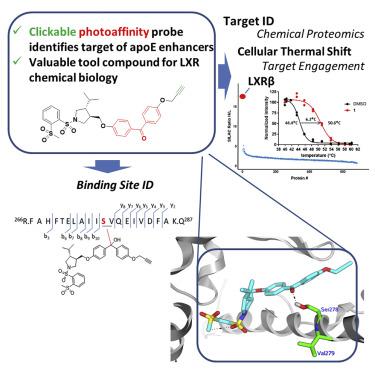Cell Chemical Biology ( IF 8.6 ) Pub Date : 2020-09-29 , DOI: 10.1016/j.chembiol.2020.09.002 Uthpala Seneviratne 1 , Zhen Huang 1 , Christopher W Am Ende 2 , Todd W Butler 2 , Leah Cleary 2 , Erica Dresselhaus 1 , Edelweiss Evrard 1 , Ethan L Fisher 2 , Michael E Green 1 , Christopher J Helal 2 , John M Humphrey 2 , Lorraine F Lanyon 2 , Michael Marconi 1 , Paramita Mukherjee 2 , Simone Sciabola 1 , Claire M Steppan 2 , Emily K Sylvain 1 , Jamison B Tuttle 1 , Patrick R Verhoest 1 , Travis T Wager 1 , Longfei Xie 2 , Gayathri Ramaswamy 1 , Douglas S Johnson 1 , Martin Pettersson 1

|
Utilizing a phenotypic screen, we identified chemical matter that increased astrocytic apoE secretion in vitro. We designed a clickable photoaffinity probe based on a pyrrolidine lead compound and carried out probe-based quantitative chemical proteomics in human astrocytoma CCF-STTG1 cells to identify liver x receptor β (LXRβ) as the target. Binding of the small molecule ligand stabilized LXRβ, as shown by cellular thermal shift assay (CETSA). In addition, we identified a probe-modified peptide by mass spectrometry and proposed a model where the photoaffinity probe is bound in the ligand-binding pocket of LXRβ. Taken together, our findings demonstrated that the lead chemical matter bound directly to LXRβ, and our results highlight the power of chemical proteomic approaches to identify the target of a phenotypic screening hit. Additionally, the LXR photoaffinity probe and lead compound described herein may serve as valuable tools to further evaluate the LXR pathway.
中文翻译:

光亲和标记和定量化学蛋白质组学确定 LXRβ 作为星形细胞 apoE 增强子的功能靶点
利用表型筛选,我们确定了体外增加星形胶质细胞 apoE 分泌的化学物质. 我们设计了一种基于吡咯烷先导化合物的可点击光亲和探针,并在人星形细胞瘤 CCF-STTG1 细胞中进行了基于探针的定量化学蛋白质组学,以识别肝 x 受体 β (LXRβ) 作为靶标。小分子配体的结合稳定了 LXRβ,如细胞热位移测定 (CETSA) 所示。此外,我们通过质谱鉴定了一种探针修饰的肽,并提出了一个模型,其中光亲和探针结合在 LXRβ 的配体结合口袋中。综上所述,我们的研究结果表明,铅化学物质直接与 LXRβ 结合,我们的结果突出了化学蛋白质组学方法在识别表型筛选目标方面的能力。此外,



























 京公网安备 11010802027423号
京公网安备 11010802027423号